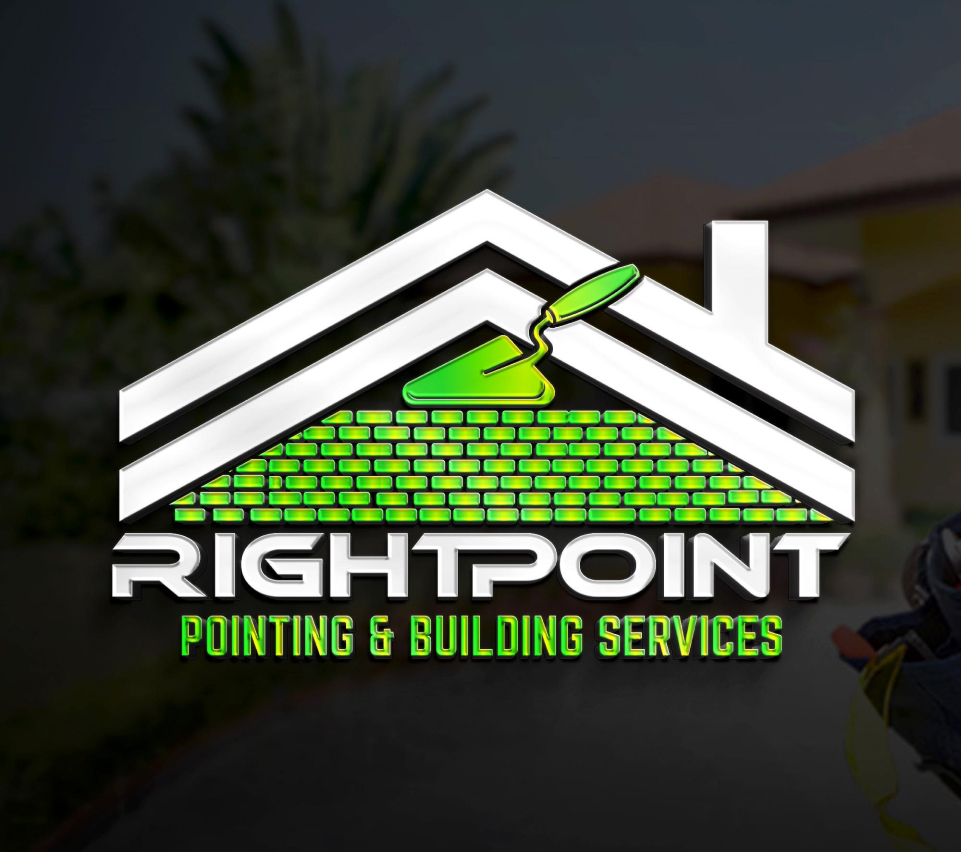How much would it cost to repoint these historical buildings
Repointing isn’t just for your average home; imagine if we could bring historical buildings back to life!
We’ve done the maths and taken a look at how much it would cost to restore some of the world’s most
historical buildings. From restoring the pyramids to a medieval makeover of Manchester Cathedral, here’s how
much it would cost to repoint some of the world’s most iconic buildings.
These are just general estimates for a bit of fun and shouldn’t be taken too seriously. The actual costs of
repointing such iconic buildings would be far more complicated, involving everything from materials to
logistics, and of course, a whole lot of history!
So, while we’ve used Right Point’s pricing methodology to give you a rough idea, there’s no doubt the real
costs would involve more than a few zeros! 😉
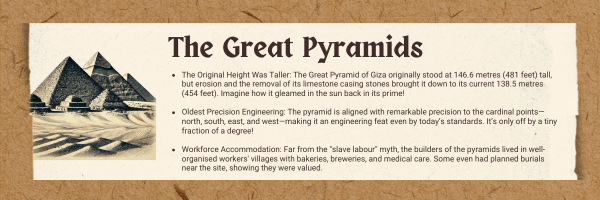
1. The Pyramids of Giza: Ancient Wonders in Need of Modern Care
Historical Background:
Built around 4,500 years ago, the Great Pyramid of Giza is
one of the Seven Wonders of the Ancient World. Constructed using massive limestone blocks, its exterior was
once encased in polished white limestone, giving it a smooth and gleaming surface that has largely worn
away. The brickwork, made of large limestone blocks, would require specific care to preserve both the
pyramid’s historical accuracy and structural integrity.
Repointing Costs:
While we’re all too aware that this colossal structure is more
than a few metres of mortar away from a quick repointing job, we’ll calculate the cost based on modern-day
pricing. With a surface area of over 50,000 square metres for the base, assuming a cost of £25-£30 per
square metre for cement mortar, and perhaps double that for lime mortar, we’re looking at a theoretical
total of around £1.5 million—though the actual cost would be far higher due to the complexity of the task!
The Pyramids have endured a lot of weathering, graffiti and wear from tourists which would significantly age
the look of the Pyramids.
Historical Construction Methods:
The pyramid’s original mortar would have been made
from a mix of sand, water, and lime, and later versions of mortar were created using a more advanced mix of
gypsum and clay to bond the massive limestone blocks.
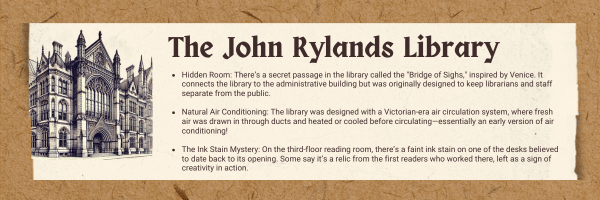
2. The John Rylands Library (Manchester)
Historical Background:
Completed in 1900, the John Rylands Library in Manchester is
a stunning example of Victorian Gothic architecture. Built with a combination of sandstone and brick, its
intricate stonework and pointed arches are a true testament to the craftsmanship of the time.
Repointing Costs:
While the John Rylands Library is not nearly as large as the Great
Pyramid, the complex brickwork of this building would require careful restoration. Using lime mortar would
likely be the best option here to maintain the integrity of the historical fabric. With an estimated 10,000
square metres of brickwork, you could be looking at a cost of £400,000 - £500,000.
Historical Construction Methods:
The building’s brickwork features traditional
Victorian Gothic construction techniques, with high attention to decorative details and the use of
decorative stonework. The mortar was a lime-based mix to match the natural ageing of the building materials.
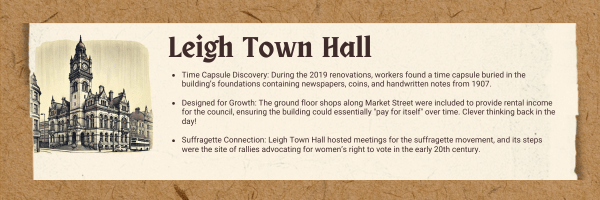
3. Leigh Town Hall (Leigh, Greater Manchester)
Historical Background:
Leigh Town Hall, designed by local architect James Caldwell
Prestwich, was completed in 1907. The building is a fine example of Edwardian Baroque architecture,
constructed from Darley Dale sandstone and Westmorland green slate.
Prestwich, born in nearby Atherton
and educated at Leigh Grammar School, returned to leave a lasting architectural legacy in his hometown. The
ground floor along the Market Street elevation originally housed a row of nine shops, adding a practical
dimension to the civic structure.
Repointing Costs:
To repoint Leigh Town Hall’s sandstone exterior and preserve its
historical charm, lime mortar would be essential to maintain its historic integrity. With an estimated 3,000
square metres of stonework, the cost could range between £120,000 and £150,000, depending on the complexity
of the decorative features.
Historical Construction Methods:
At the time of its construction, the use of Darley
Dale sandstone was a deliberate choice for its durability and elegance. Westmorland green slate is used on
the roof for practicality but to also make for a visually striking appearance. The original mortar mix would
have been lime-based, allowing the building to breathe and adapt to the natural weathering over time.
Recent Renovations:
Between 2019 and 2021, Leigh Town Hall underwent a major £1.3
million restoration funded by the National Lottery Heritage Fund and Wigan Council. An extensive archive in
the basement now houses 800 years of local history, making it a vital resource for the community. The
addition of a public archive search room and a conservation studio for digitising records ensures that the
history of Leigh is more accessible than ever.
A Nostalgic Touch:
For us at Right Point, Leigh Town Hall isn’t just a landmark—it’s
part of our heritage. I remember growing up playing outside the front of Leigh Town Hall, those warm summer,
Sunday evenings when the town would be quiet.
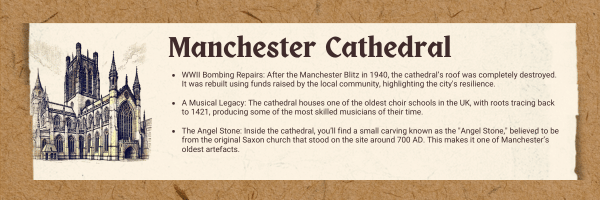
4. Manchester Cathedral (Manchester)
Historical Background:
Manchester Cathedral, originally built in 1421, stands as a
remarkable example of medieval architecture in the heart of the city. Constructed predominantly from local
sandstone, its intricate stonework tells a story of craftsmanship and resilience. The cathedral has
withstood centuries of weathering, urban development, and even bombing during World War II, making its
preservation a vital part of Manchester’s heritage.
Repointing Costs:
Repointing a building of this historical importance would be a
meticulous task, requiring lime mortar to maintain the structure’s integrity and authenticity. With an
estimated 5,000 square metres of stonework, the cost for repointing could range from £200,000 to £250,000,
depending on the level of detail required for the intricate carvings and weathered sections.
Historical Construction Methods:
The cathedral’s sandstone blocks were quarried
locally, showcasing the natural materials of the area. Builders in the 15th century used lime mortar to bind
the stones, which allowed the structure to breathe and adapt to the environment over time. This traditional
construction method is why using modern cement-based mortar during restoration would risk damaging the
delicate stonework. Lime mortar, with its flexibility and permeability, remains the best choice for
maintaining the building’s historical integrity.
Can you repoint a listed building?
Yes, listed buildings can be repointed. Although it’s not as easy as just booking us for a local callout. Typically you’d have to obtain listed building consent from the local planning authority before carrying out any work. There’s a lot to consider when repointing a listed building, as pointing can significantly change the look and character of a building.
Key points to remember when repointing a building:
- Choose the Right Mortar
Not all mortar is created equal. For older or listed buildings, a traditional lime-based mortar is an absolute must. It allows the building to "breathe" by letting moisture escape, which prevents damage to the bricks or stonework. Matching the colour and texture to the existing mortar is just as important for a seamless finish. - Bring in the Experts
Repointing isn’t just slapping on new mortar—it’s a skilled craft. Work with a qualified conservation specialist or a contractor experienced in heritage restoration (like us!) to get it right. A poorly done job can cause long-term damage and stick out like a sore thumb. - Assess the Existing Mortar
Take a good look at what’s already there. Analysing the existing mortar’s composition helps ensure the new mix will be compatible. Using the wrong mortar can weaken the structure or accelerate decay. - Check with Your Local Planning Authority
If you’re working on a listed or protected building, don’t skip this step. Your local planning authority needs to know about your plans. Some projects require consent, and it’s better to be safe than sorry when dealing with building regulations. - Prioritise Quality Materials
This isn’t the time to cut corners. Invest in high-quality lime mortar and other materials that will stand the test of time. It’s worth it to preserve the character and structural integrity of the building. - Don’t Forget the Details
Heritage buildings often have unique features—decorative brickwork, intricate stone carvings, or even inscriptions. Repointing these requires a steady hand and attention to detail, so make sure your contractor has the experience to handle it. - Think About the Weather
Timing matters. Repointing should ideally be done in mild, dry weather to give the new mortar the best chance to cure properly. Extreme heat, frost, or heavy rain can affect the quality of the work.
By keeping these points in mind, you’ll not only protect the building’s history but ensure it remains standing tall for generations to come. At Right Point, we’ve got the expertise to handle every detail, so your restoration is done right the first time.
We hope you liked our trip down memory lane, from repointing The Great Pyramids of Giza, to iconic buildings in Manchester and Leigh. Please keep in mind that without seeing a building in person, it’s hard to assess the price of the work. We’ve used basic pricing principles to bring together this hypothetical piece.
Looking for brickwork repointing near you? We cover Manchester, Wigan, Leigh and surrounding areas. Get in touch today for a free quotation by calling 07979754342 or 07498421411
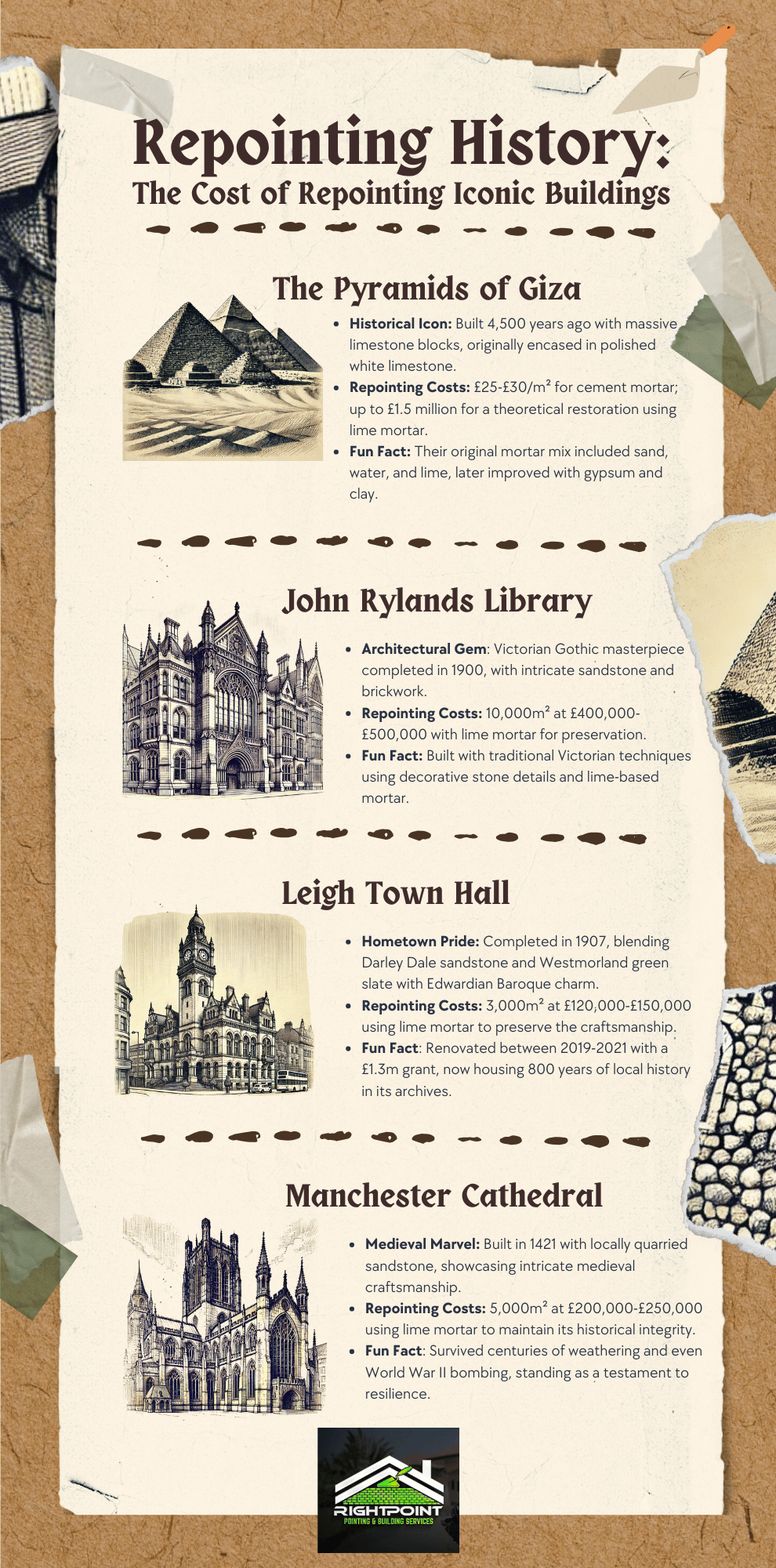
FAQs
We’ve put together answers to some of the most common questions about our repointing services. If there’s something we haven’t covered, don’t hesitate to get in touch through our contact page.
How do I know if my brickwork needs repointing?
Look for signs like crumbling mortar, gaps in the joints, or water ingress. If your mortar is no longer holding bricks securely, it’s time for repointing.
What is the best time of year to repoint brickwork?
Repointing is best done during mild weather, typically in spring or autumn, to ensure the mortar sets correctly without being affected by extreme heat or frost.
Can repointing stop damp in my home?
Yes, repointing can help prevent damp by sealing gaps in the mortar where water might penetrate, protecting your home from moisture-related damage.
How long does repointing last?
Properly done repointing can last 30–50 years, depending on the quality of the materials and exposure to weather.
How much does repointing brickwork cost?
The cost varies depending on the size of the area, the type of mortar used, and the labour involved. It's best to get a quote for an accurate estimate.
Is repointing a DIY job or should I hire a professional?
While minor repairs might be tackled by experienced DIYers, full repointing requires professional skills to ensure structural integrity and a neat finish.
How long does repointing take?
The duration depends on the size and condition of the area being repointed, but most jobs are completed within a few days to a week.
Can repointing improve the energy efficiency of my home?
Yes, repointing can help reduce draughts and heat loss through gaps in the mortar, improving your home's insulation.
What are the alternatives to repointing brick?
If your brickwork is showing signs of wear but repointing isn't an option, there are alternatives to consider. Brick sealing can help protect the masonry by creating a water-resistant barrier, while crack stitching uses stainless steel rods to stabilize damaged walls. For a complete refresh, rendering or cladding can provide a new, durable surface over existing bricks. Each option has its advantages depending on the condition of your brickwork and your budget. At Right Point, we can assess your masonry and recommend the best solution to restore its strength and appearance.
Get in touch
If you have any queries or would like to register your interest in RightPoint, please do get in touch on any of the following:
